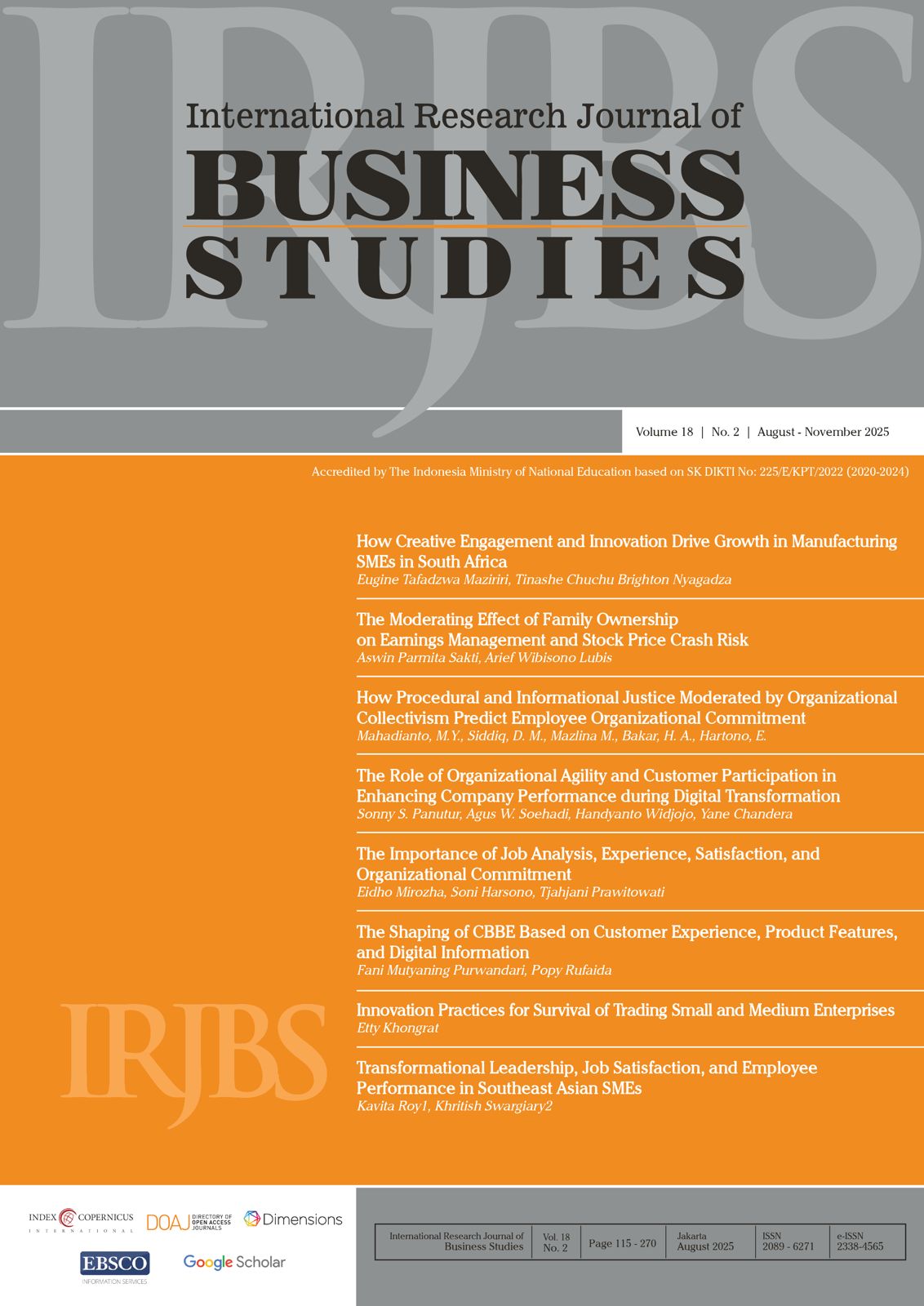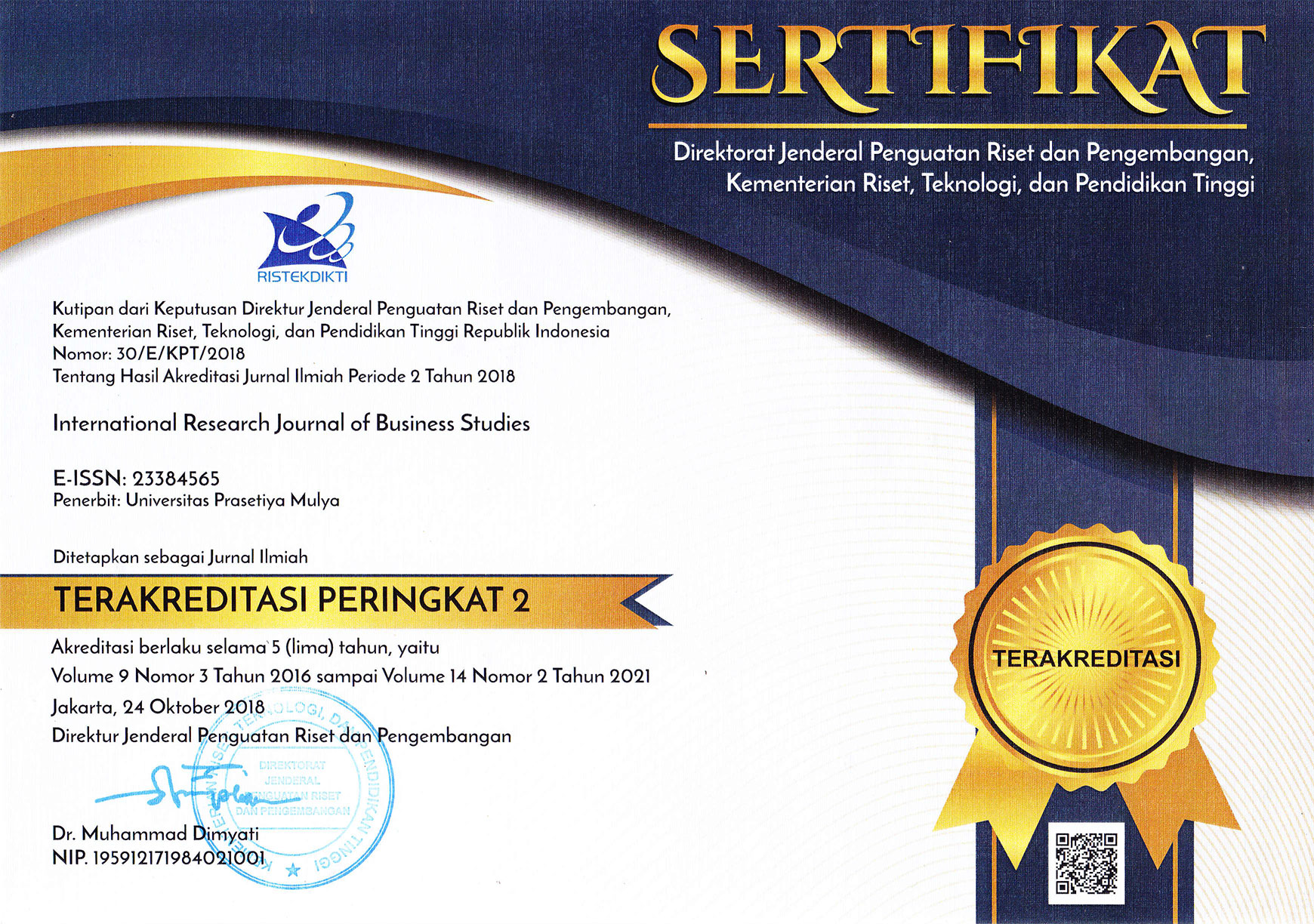How Procedural and Informational Justice Moderated by Organizational Collectivism Predict Employee Organizational Commitment
DOI:
https://doi.org/10.21632/irjbs.18.2.159-173Keywords:
organizational justice, organizational collectivism, organizational commitment, rural banking sectorAbstract
This study tested the perceived procedural and informational justices in predicting commitment among employees at rural banking sector. The paper assumes that the direct link of perceived procedural and informational justices with organizational commitment is moderated by organizational collectivism. For this end, the study used a survey method and analyses using Partial Least Squares 3 (PLS- SEM) from 284 Indonesian rural bank employees in Indonesia. The results suggest the following. First, procedural, and informational justice are two predictors of employee commitment to organizations. Second, organizational collectivism significantly moderates the relationship between procedural justice and employee commitment, but failed to moderate the relationship between informational justice and employee commitment. This study is the first one to examine the moderating effect of organizational collectivism on the relationship between procedural and informational justice with employee commitment.
References
Adams, J. S. (1965), “Inequity in social exchange”, In Advances in Experimental Social Psychology. Vol. 2 pp.267-299.
Akintayo D. (2010), “Work-family role conflict and organizational commitment among industrial workers in Nigeria”, Journal of Counseling Psychology, Vol. 2 No 1, pp.1-8.
Allen, N. J., & Meyer, J. P. (1990), “The measurement and antecedents of affective, continuance and normative commitment to the organization”, Journal of Occupational Psychology, Vol. 63 pp.1-18.
Andrew, T. E. (2017), “Organizational justice and employee commitment: Evidence from University of Benin”, SSRG International Journal of Economics and Management Studies (SSRG-IJEMS), Vol. 6 No 7, pp.84-91.
Aryee, S., Budhwar, P. S., & Chen, Z. X. (2002), “Trust as a mediator of the relationship between organization justice and work outcomes: Test of social exchange model”, Journal of Organizational Behavior, Vol. 23, pp.267-285.
Brislin, R. W. (1970), “Back-translation for cross-cultural research”, Journal of Cross-Cultural Psychology, Vol. 1 No. 3, pp.185-216.
Choudhry, N., Philip, P. J., & Kumar, R. (2011), “Impact of organizational justice on organizational effectiveness”, Industrial Engineering Letters, Vol. 1 No 3, pp.18-24.
Colquitt, J. A. (2001), “On the dimensionality of organizational justice: A construct validation of a measure”, Journal of Applied Psychology, Vol. 86 No 3, pp.386-400.
Colquitt, J. A., & Chertkoff, J. M. (2002), “Explaining injustice: The interactive effects of explanation and outcome on fairness perceptions and task motivation”, Journal of Management, Vol. 28 pp. 591-610.
Cropanzano, R., Prehar, C. A., & Chen, P. Y. (2002), “Using social exchange theory to distinguish procedural from interactional justice”, Group & Organization Management, Vol. 27 No. 3, pp.324-351.
Dawson, J. F. (2014), “Moderation in management research: What, why, when and how”, Journal of Business and Psychology, Vol. 29 pp.1-19.
Folger, R., & Konovsky, M. A. (1989), “Effects of procedural and distributive justice on reactions to pay raise decisions”, Academy of Management Journal, Vol. 32 No 1, pp.115-130.
Francesco, A. M., & Chen, Z. X. (2004), “Collectivism in action its moderating effects on the relationship between organizational commitment and employee performance in China”, Group & Organization Management, Vol. 29 No 4, pp.425-441.
Gefen, D. and D. Straub (2000), “The Relative Importance of Perceived Ease-of Use in IS Adoption: A Study of e-Commerce Adoption," Journal of the Association for Information Systems, Vol. 1 No. 8, pp. 1-30.
Ghosh, P., Rai, A., & Sinha, A. (2014), “Organizational justice and employee engagement: Exploring the linkage in public sector banks in India,” Personnel Review, Vol. 43 No. 4, pp. 628-652.
Ghulam, M., Ikramullah, S., Khurram, S., Muhammad, K. S., & Nadeem, A. K. (2011), “Impact of distributive and procedural justice on employees’ commitment: A case of public sector organization of Pakistan,” European Journal of Economics, Finance and Administrative Sciences, Vol. 29 pp.73-80.
Greenberg, J. (1987), “Reactions to procedural injustice in payment distributions: Do the means justify the ends?”, Journal of Applied Psychology, Vol. 72 No.1, pp. 55-61.
Greenberg, J. (1990), “Organizational justice: Yesterday, today, and tomorrow”, Journal of Management, Vol. 16 No.2, pp.399-432.
Greenberg, J. (1993), “The social side of fairness: Interpersonal and informational classes of organizational justice”, Russel C (Ed.), Series in applied psychology. Justice in the workplace: Approaching fairness in human resource management, Lawrence Erlbaum Associates, Inc, pp. 79–103.
Griffin, R., & Moorhead, G. (2007), Organizational behavior: Managing people and organizations. 18th Edition, Houghton Mifflin Company, Boston.
Hair, J. F., Hult, G. T. M., Ringle, C. M., & Sarstedt, M. (2014), A primer on partial least squares structural equation modelling. SAGE, Thousand Oaks, CA.
Hair, Joseph F. and Risher, Jeffrey J. and Sarstedt, Marko and Ringle, Christian M. (2019), “When to Use and How to Report the Results of PLS-SEM”, European Business Review, Vol. 31 No 1 pp. 2-24.
Hassan, Arif, & Hashim, Junaidah (2011), “Role of organizational justice in determining work outcomes of national and expatriate academic staff in Malaysia”, International Journal of Commerce and Management, Vol. 21 No.1, pp.82-93.
Henseler, J. & Fassott, G. (2010), “Testing moderating effects in PLS path models: An illustration of available procedures”, In Handbook of partial least squares: Concepts, methods and applications in marketing and related fields. Springer, Berlin, pp. 713-735.
Henseler, J., Ringle, C. M., & Sarstedt, M. (2015), “A new criterion for assessing discriminant validity in variance-based structural equation modeling”, Journal of the Academy of Marketing Science, Vol. 43 No. 1, pp.115–135.
Holley, E. C., Wu, K., & Avey, J. B. (2019), “The impact of leader trustworthiness on employee voice and performance in China”, Journal of Leadership & Organizational Studies, Vol. 26 No 2, pp.179-189.
Johns, G. (2001), “In praise of context”, Journal of Organizational Behavior, Vol. 22 No. 1, pp.31-42.
Jones, G. R., & George, J. M. (2016), Management. 9th Edition. McGraw-Hill Education, New York, NY.
Kim, H.-S. (2009), “Examining the role of informational justice in the wake of downsizing from an organizational relationship management perspective,” Journal of Business Ethics, Vol. 88 No.2, pp.297-312.
Kline, R. B. (2011), Principles and Practice of Structural Equation Modeling. Guilford Press, New York.
Lambert, L. (2003), Leadership Capacity for Lasting School Improvement. ASCD, Alexandria, VA.
Masterson, S. S., Byrne, Z. S., & Mao, H. (2005). Interpersonal and informational justice: Identifying the differential antecedents of interactional justice behaviors. In Stephen W. G, Dirk D.S., Daniel P.S., Kees van den, B. (Eds.), What motivates fairness in organizations? (pp. 79–103). Information Age Publishing, Greenwich, CT.
McShane, S. L., & Von Glinow, M. A. (2020), Organizational behavior: Emerging knowledge. Global Reality 9th Edition. McGraw-Hill Education, New York, NY.
Mensah, H. K., Asiamah, N., & Mireku, K. (2016), “The effect of organizational justice delivery on organizational commitment: Controlling for key confounding variables”, Journal of Global Responsibility, Vol. 7 No. 2, pp.196-209.
Mowday, R. T., Steers, R. M., & Porter, L. W. (1979), “The measurement of organizational commitment”, Journal of Vocational Behavior, Vol. 14 No. 2, pp.224-247.
Naidu, P., Sharif, M. Y., & Poespowidjojo, D. A. L. (2014). Informational justice in performance appraisal and its influence on organizational commitment of UUM lecturers. Paper presented at International Conference on Business Management (ICBM) 2014, Las Vegas. available at http://repo.uum.edu.my/id/eprint/15014/ (accessed 3 March 2022).
Nazim, A., & Shahid, J. (2012), “Relationship between organizational justice and organizational commitment and turnover intentions amongst medical representatives of pharmaceuticals companies of Pakistan” Journal of Management Sciences, Vol. 6 No. 2, pp.201-212.
Parkes, L. P., Bochner, S., Schneider, S. K. (2001), “Person-organization fit across cultures: An empirical investigation of individualism and collectivism” Applied Psychology-An International Review-Psychologie Applique-Revue Internationale, Vol. 50, pp.81-108.
Qaisar, M. U., Rehman, M. S., & Suffyan. M. (2012), “Exploring effects of organizational commitment on employee performance: Implications for human resource strategy”, Interdisciplinary Journal of Contemporary Research in Business, Vol. 3 No. 11, pp.248 – 255.
Robbins, S.P., & Judge, T. A. (2018), Essentials of Organizational Behavior 14th Edition. Pearson Education, London.
Robert, C., & Wasti, S. A. (2002), “Organizational Individualism and Collectivism: Theoretical Development and an Empirical Test of a Measure” Journal of Management, Vol. 28 No. 4, pp. 544-566.
Sweeney, P. D., & McFarlin, D. B. (1997), “Process and outcome: Gender differences in the assessment of justice” Journal of Organizational Behavior”, Vol. 18 No. 1, pp. 83-98.
Teo, T. S. H., Srivastava, S. C., & Jiang, L. (2008), “Trust and electronic government success: an empirical study”, Journal of Management Information Systems, Vol. 25 No. 3, pp. 99–132.
Triandis, H. C. (1995). Individualism & Collectivism. Westview Press, Boulder, CO.
Colquitt, J. A. (2001). On the dimensionality of organizational justice: A construct validation of a measure. Journal of applied psychology, 86(3), 386-400.
Ghosh, P., Rai, A., & Sinha, A. (2014). Organizational justice and employee engagement: Exploring the linkage in public sector banks in India. Personnel Review.
Greenberg, J. (1987). Reactions to procedural injustice in payment distributions: Do the means justify the ends? Journal of applied psychology, 72(1), 55.
Kim, H.-S. (2009). Examining the role of informational justice in the wake of downsizing from an organizational relationship management perspective. Journal of Business Ethics, 88(2), 297-312.
Naidu, P., Sharif, M. Y., & Poespowidjojo, D. A. L. (2014). Informational justice in performance appraisal and its influence on organizational commitment of UUM lecturers. Paper presented at the International Conference on Business Management, Las Vegas.
Sweeney, P. D., & McFarlin, D. B. (1997). Process and outcome: Gender differences in the assessment of justice. Journal of Organizational Behavior, 18(1), 83-98.
Downloads
Submitted
Accepted
Published
How to Cite
Issue
Section
Categories
License
Copyright (c) 2025 Moh Yudi Mahadianto, Dedi Muhammad Siddiq, Mazlina Mamat, Hatinah Abu Bakar, Edy Hartono (Author)

This work is licensed under a Creative Commons Attribution-ShareAlike 4.0 International License.
Journal Author(s) Rights
For IRJBS to publish and disseminate research articles, we need publishing rights (transferred from the author(s) to the publisher). This is determined by a publishing agreement between the Author(s) and IRJBS. This agreement deals with the transfer or license of the copyright of publishing to IRJBS, while Authors still retain significant rights to use and share their own published articles. IRJBS supports the need for authors to share, disseminate and maximize the impact of their research and these rights, in any databases.
As a journal Author, you have rights to many uses of your article, including use by your employing institute or company. These Author rights can be exercised without the need to obtain specific permission. Authors publishing in IRJBS journals have comprehensive rights to use their works for teaching and scholarly purposes without needing to seek permission, including:
- use for classroom teaching by Author or Author's institution and presentation at a meeting or conference and distributing copies to attendees;
- use for internal training by the author's company;
- distribution to colleagues for their research use;
- use in a subsequent compilation of the author's works;
- inclusion in a thesis or dissertation;
- reuse of portions or extracts from the article in other works (with full acknowledgment of the final article);
- preparation of derivative works (other than commercial purposes) (with full acknowledgment of the final article);
- voluntary posting on open websites operated by the author or the author’s institution for scholarly purposes,
(But it should follow the open access license of Creative Common CC-by-SA License).
Authors/Readers/Third Parties can copy and redistribute the material in any medium or format, as well as remix, transform, and build upon the material for any purpose, even commercially. Still, they must give appropriate credit (the name of the creator and attribution parties (authors' detail information), a copyright notice, an open access license notice, a disclaimer notice, and a link to the material), provide a link to the license, and indicate if changes were made (Publisher indicates the modification of the material (if any) and retain an indication of previous modifications.
Authors/Readers/Third Parties can read, print and download, redistribute or republish the article (e.g. display in a repository), translate the article, download for text and data mining purposes, reuse portions or extracts from the article in other works, sell or re-use for commercial purposes, remix, transform, or build upon the material, they must distribute their contributions under the same license as the original Creative Commons Attribution-ShareAlike (CC BY-SA).
This work is licensed under a Creative Commons Attribution-ShareAlike 4.0 International License.








